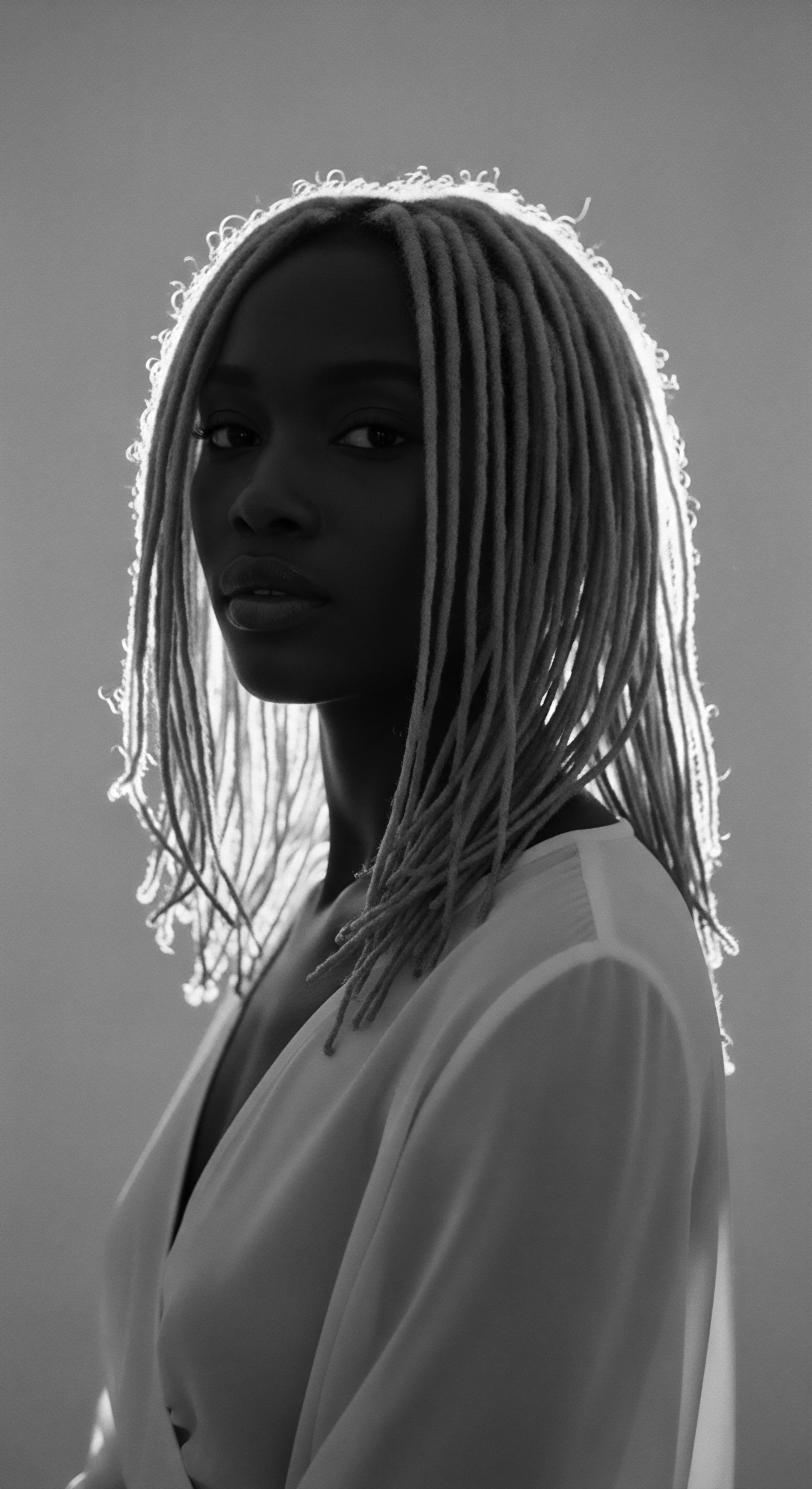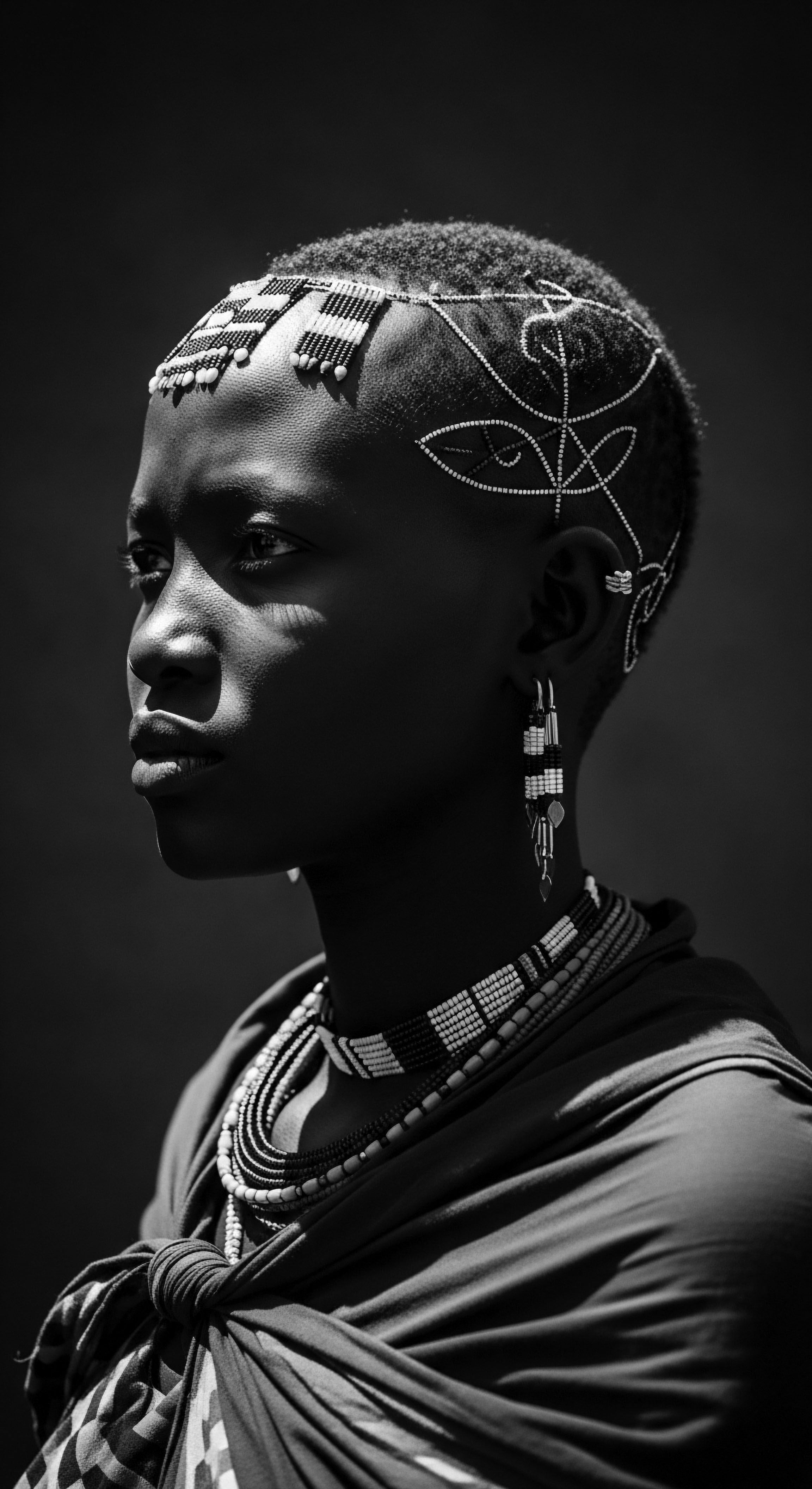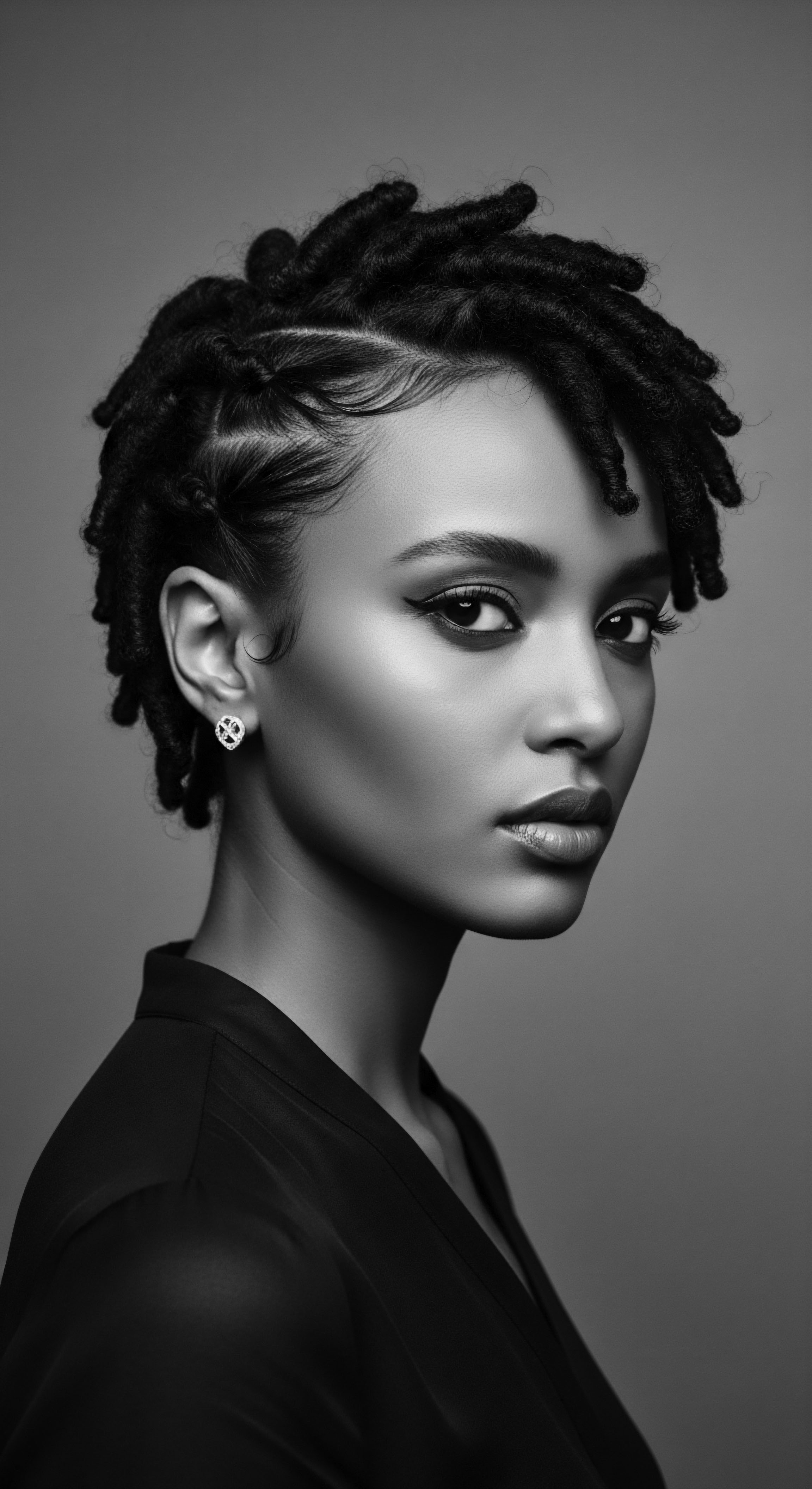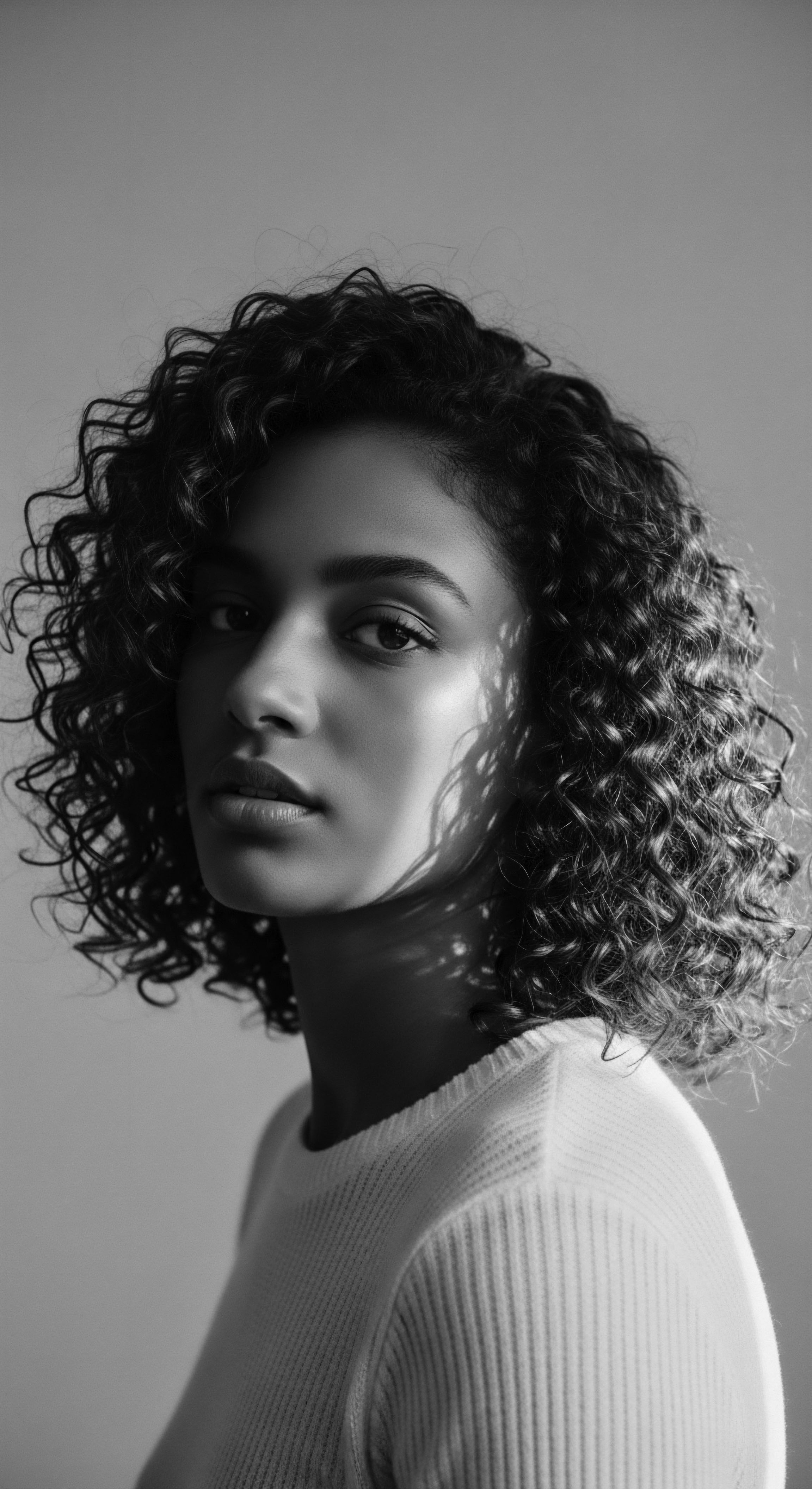
Roots
In the quiet spaces of our understanding, where memory and ancestral resonance converge, lies the profound story of textured hair. It is not a mere biological attribute, nor a passing trend. Each coil, every wave, every tightly woven strand carries within it the very breath of time, a living archive whispered across continents and generations. For those who bear this crown, it represents a testament to enduring spirit, a defiance etched into the genetic code, a living chronicle of how textured hair has steadfastly resisted the tides of cultural erasure.
To truly grasp this profound defiance, we must first descend to the elemental, to the very source of what makes textured hair so uniquely resilient. Its anatomy, often misunderstood or miscategorized through colonial lenses, reveals a marvel of biological engineering. Unlike straight strands that emerge in a perfect, symmetrical circle, the follicle of textured hair takes on an elliptical or kidney-bean shape.
This inherent asymmetry, coupled with the unique distribution of disulfide bonds within the keratin, compels the hair shaft to curl, bend, and twist upon itself. It is this fundamental, anatomical design that gives textured hair its characteristic spring, its natural volume, and its ability to intertwine into intricate patterns that have served as profound markers of identity, status, and community throughout history.

Anatomy and Ancestral Knowledge
The science of textured hair, as we comprehend it today, often validates what ancestral communities knew through observation and intuitive understanding. The helical structure of the strand, prone to unique patterns of hydration and moisture loss due to its raised cuticle scales, necessitates specific care. This knowledge, passed down through oral traditions and hands-on guidance, predates modern trichology by millennia.
Consider the wisdom embedded in practices like heavy oiling and braiding, which provided protective envelopes for delicate strands in arid climates or during demanding labor. These were not simply acts of beautification; they were acts of preservation, born of an intimate dialogue between human beings and the natural world, safeguarding the hair’s vitality and, in turn, the spirit of the people.
The very architecture of textured hair, from its elliptical follicle to its intricate coil, is a biological testament to endurance, holding centuries of ancestral wisdom within its form.
The lexicon surrounding textured hair, too, is a living, breathing aspect of its heritage, constantly evolving yet tethered to deep roots. While modern classification systems (like the familiar 1A-4C scale) attempt to categorize curl patterns, they often fall short of capturing the rich diversity and the social significance woven into the hair’s very naming. Historically, terms were often descriptive of the hair’s appearance but also its connection to one’s lineage, region, or marital status.
In many West African societies, the specific style and texture could convey an entire narrative without a single word being spoken. The language used, then and now, extends beyond mere description; it is a means of connection, a way to articulate identity and belonging within a collective memory.
The growth cycles of textured hair, too, have shaped ancestral practices. The relatively shorter anagen (growth) phase for some textured hair types compared to straight hair, coupled with its natural fragility at the bends, meant that care traditions focused on minimizing breakage and maximizing retention. This led to the widespread adoption of protective styles that guard the ends, creating an environment where the hair could flourish, quietly defying the environmental stressors or the destructive forces of oppressive systems intent on diminishing its inherent strength.

Tracing Hair Classification Through Time
While contemporary systems seek to categorize, ancestral communities possessed their own intricate ways of recognizing and honoring hair diversity. These were not rigid classifications but fluid understandings born from observation, communal recognition, and the unique ways hair behaved within distinct kinship groups. The very concept of ‘good hair’ and ‘bad hair’ is a deeply ingrained, painful legacy of colonial influence and its insidious attempt to standardize beauty ideals, divorcing hair from its ancestral context and imposing a Eurocentric hierarchy.
Before this imposition, hair was simply hair—a gift, a canvas, a connection. Its varied textures were celebrated as reflections of the Creator’s artistry, each type holding its own unique beauty and requiring its own respectful care.
- Kinky Coils ❉ Often used to describe tightly wound hair, these coils are celebrated for their density and versatility in many traditional African cultures.
- Springy Curls ❉ Characterized by defined, often bouncy curls, these have been admired for their inherent elasticity and vibrant movement.
- Wavy Patterns ❉ Flowing textures that can range from loose waves to more defined S-shapes, cherished for their soft fluidity in various ancestral communities.
These ancient understandings form the true foundation of our contemporary lexicon. They remind us that the ‘classification’ of textured hair began not in a laboratory, but in the hands of mothers, aunties, and revered hair elders, whose insights were honed by generations of practice and intimate observation of the strand’s deepest inclinations.

Ritual
The transformation of a biological reality into a profound cultural statement is perhaps best observed in the sacred, enduring rituals surrounding textured hair. These practices, far from being mere acts of grooming, are living inheritances, intricate dances of hands, tools, and shared knowledge that have steadfastly resisted attempts to diminish or erase their significance. They represent how textured hair has defied cultural erasure not through grand declarations, but through the quiet, persistent rhythm of daily and communal care.

Protective Styling as Ancestral Wisdom
Consider the expansive encyclopedia of protective styles—braids, twists, cornrows, and buns. Each of these styles, in its myriad forms, carries ancestral echoes. These were not invented in a vacuum; they were ingenious solutions born of necessity, artistry, and deep environmental understanding. In many West African societies, cornrows, for instance, were more than just a style.
They conveyed age, marital status, wealth, and even religious devotion. The patterns often mirrored agricultural fields, symbolizing fertility and interconnectedness. During the transatlantic slave trade, these styles became clandestine maps to freedom, strands braided with rice or seeds, a literal and symbolic rebellion. Dr.
Caroline Lee of Hampton University notes that enslaved people often used cornrows to “map out their escape routes” and carry provisions, making hair an integral part of survival and resistance (Lee, 2013). This act—wearing one’s identity and hope for freedom on one’s head—was an unparalleled act of defiance against a system designed to erase every vestige of African identity.
The tools employed in these rituals also hold deep heritage. From carved wooden combs, sometimes adorned with spiritual symbols, to natural fibers used for extensions, these implements were extensions of the hand, crafted with purpose and reverence. They speak of a time when every object held meaning, every touch was intentional. The art of braiding, passed from elder to youth, transcended mere technique; it was an intergenerational transfer of wisdom, a moment of intimate connection, a space where stories were shared and heritage was reinforced, strand by precious strand.
Hair rituals are living testimonies, quietly defiant acts of heritage that transform biological reality into profound cultural statements.
Even modern styling techniques, often framed as new inventions, frequently trace their lineage back to these foundational practices. The ‘wash and go’ for instance, while a contemporary term, conceptually aligns with the historical appreciation for the hair’s natural form, a celebration of its inherent beauty without manipulation. The deep conditioning treatments we use today echo the traditional practices of infusing hair with natural butters, oils, and plant extracts, a testament to long-held ancestral knowledge of botanical properties.

Why are Traditional Styling Techniques so Resilient?
The resilience of these traditional styling techniques lies in their multi-layered function. They are not simply aesthetic. They protect the hair from environmental damage, minimize tangling, and allow for extended periods between manipulations, thereby promoting length retention.
This practical utility, combined with their profound cultural and artistic value, has ensured their survival across centuries. The continuous adaptation and re-emergence of these styles in contemporary settings—from vibrant cornrow designs on runways to the widespread adoption of twists and locs in professional spaces—speaks to their undeniable power as statements of identity and heritage, constantly pushing against imposed norms of uniformity.
| Ancestral Practice Coiling with Butters ❉ Using shea butter or other plant-based emollients to define and protect coils, often with finger manipulation. |
| Modern Parallel/Understanding Curl Cream Application ❉ Formulations designed to enhance curl definition and provide moisture, often incorporating shea or cocoa butter. |
| Ancestral Practice Thread Wrapping ❉ A method of stretching and protecting hair by wrapping it tightly with thread, common in West African traditions. |
| Modern Parallel/Understanding Heatless Stretching Techniques ❉ Bunning, banding, or roller sets that achieve elongation without direct thermal exposure. |
| Ancestral Practice Scalp Massage with Oils ❉ Stimulating the scalp with herbal-infused oils to promote growth and health. |
| Modern Parallel/Understanding Pre-Poo Treatments and Scalp Massagers ❉ Targeted treatments and tools designed to nourish the scalp and encourage circulation for hair vitality. |
| Ancestral Practice These parallels underscore the enduring wisdom embedded in ancestral hair care, adapted but not diminished by time. |
The very act of caring for textured hair, then, becomes a ritual of reclamation. Each brushstroke, each sectioning, each twist or braid is a reaffirmation of a heritage that was systematically devalued. It transforms mundane maintenance into a meditative connection with ancestors, a celebration of a legacy that refused to be silenced, even when voices were.

Relay
The defiant journey of textured hair is not merely a tale of historical resilience; it is a living relay, a continuous transfer of profound identity and communal strength across generations. This section considers how textured hair, particularly Black and mixed-race hair, has served as a powerful medium for cultural memory, resistance, and self-definition, asserting its inherent value in the face of ongoing attempts at cultural diminishment. The relay extends from ancient traditions to contemporary expressions, a dynamic dialogue between past and present that consistently reclaims space and asserts heritage.

Hair as a Symbol of Identity and Resistance
Throughout the African diaspora, textured hair has consistently functioned as a profound identifier, a visual marker of belonging and a silent protest against enforced assimilation. During periods of enslavement and subsequent racial oppression, the deliberate degradation of Black hair was a key tool in systemic dehumanization. Laws and social conventions often dictated that textured hair be covered, straightened, or otherwise concealed to align with Eurocentric beauty standards. The Tignon Laws enacted in Louisiana in 1786, forcing Black women to cover their hair with scarves, stand as a stark historical example.
These laws, ostensibly about social distinction, were thinly veiled attempts to erase the visible markers of Black women’s beauty and status, particularly their elaborate hairstyles (Glick, 2017). Yet, these women transformed the very scarves meant to suppress their identity into acts of sartorial defiance, tying them in elaborate, beautiful ways that still expressed their aesthetic flair and inherent dignity.
The 20th century witnessed powerful affirmations of textured hair within liberation movements. The Afro of the 1960s and 70s, for instance, was not simply a hairstyle; it was a potent political statement. It symbolized a rejection of oppressive beauty norms, a celebration of Black power, and a direct link to African roots. This deliberate choice to wear one’s hair in its natural, untamed state was a highly visible act of cultural self-possession, directly confronting the societal pressure to conform.
This sentiment found validation decades later with legislative action. The CROWN Act (Creating a Respectful and Open World for Natural Hair), first passed in California in 2019 and now adopted in numerous states, legally prohibits discrimination based on hair texture or protective hairstyles associated with race (CROWN Act, n.d.). This modern legislative movement is a direct descendant of centuries of quiet, and sometimes overt, defiance. It codifies the understanding that textured hair is not a mere aesthetic choice, but a fundamental aspect of racial and cultural identity, deserving of protection and respect.

Cultural Affirmation Through Innovation and Community
The continuing relay of textured hair’s defiance is also seen in the vibrant ecosystem of innovation and community that has sprung up around it. When mainstream markets failed to cater to the unique needs of textured hair, Black entrepreneurs and innovators stepped into the void, drawing on ancestral knowledge to formulate products and create tools that truly served their communities. From the early 20th-century pioneers like Madam C.J.
Walker, whose hair care systems were rooted in understanding Black women’s needs, to contemporary indie brands, this self-sufficiency is a powerful act of economic and cultural autonomy. It proves that despite systemic barriers, the capacity to create, sustain, and celebrate one’s heritage remains potent.
The collective wisdom within Black and mixed-race communities, shared in kitchens, barbershops, and salons, forms an invisible but unbreakable chain in this relay. These spaces are not just places for hair care; they are hubs of cultural transmission, where stories are exchanged, traditions are kept alive, and identity is affirmed. Here, the knowledge of proper detangling, the art of sectioning, the application of various oils and butters, and the mastery of intricate braiding patterns are passed down, often informally, yet with profound impact. This communal learning ensures that the heritage of textured hair care remains vibrant, adaptive, and resistant to dilution.
The journey of textured hair is, at its heart, a narrative of unyielding spirit. It is the story of a culture that refused to be silenced, choosing instead to speak volumes through its very appearance. The legacy of resilience, inscribed in every twist and turn of a strand, continues to challenge monolithic beauty standards, asserting a vibrant, multifaceted heritage that stands as a living testament to self-determination and the power of inherited wisdom.

Reflection
As we contemplate the journey of textured hair, from the intricate helix of its earliest beginnings to its powerful presence in our modern world, we find a story that is far grander than mere strands and styles. This is a story of enduring spirit, of a continuous, quiet rebellion against the forces that sought to diminish or silence a people. Roothea’s ‘Soul of a Strand’ ethos reminds us that each coil holds within it a universe of ancestral wisdom, a living memory of defiance and beauty.
Textured hair has not merely survived erasure; it has thrived in its face. It has done so by remaining an undeniable physical manifestation of a rich cultural heritage, a canvas for storytelling, a symbol of liberation, and a profound personal declaration. It is a testament to the fact that what grows from our heads can be an unwavering source of identity, strength, and connection to a lineage of remarkable resilience.
Our exploration affirms that the heritage of textured hair is not a relic of the past; it is a living, breathing force, shaping identities, fostering community, and inspiring futures. It is, unequivocally, a crown worn with pride, reflecting centuries of unwavering spirit.

References
- Glick, D. (2017). The Tignon Laws ❉ A Legacy of Resistance. Journal of Creole Studies, Vol. 9, No. 2.
- Lee, C. (2013). Hair Story ❉ Untangling the Roots of Black Hair in America. Hampton University Press.
- CROWN Act. (n.d.). About The CROWN Act. The CROWN Coalition. (Note ❉ While the CROWN Act information is widely available, this entry refers to the legislative initiative itself as a historical/social reference point, not a specific published work in the traditional sense. For a strict academic paper, one would cite a legal journal article analyzing the act’s impact.)
